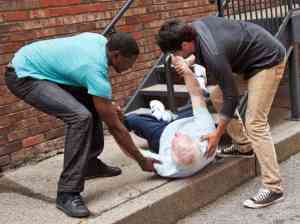 Each year, many injuries result from falls. In most of these cases, a variety of factors combine to cause the fall. Some of these risk factors (such as side effects of medication and environmental factors) can be mitigated, while others (such as age and vision problems) cannot. For most people, a fall is a minor event, resulting in minor injuries, if any. In some cases, however, especially in elderly individuals, a fall can result in a fracture or other serious injury. In severe cases, long-term disability and even death can result from a fall.
Each year, many injuries result from falls. In most of these cases, a variety of factors combine to cause the fall. Some of these risk factors (such as side effects of medication and environmental factors) can be mitigated, while others (such as age and vision problems) cannot. For most people, a fall is a minor event, resulting in minor injuries, if any. In some cases, however, especially in elderly individuals, a fall can result in a fracture or other serious injury. In severe cases, long-term disability and even death can result from a fall.
The risk of falling increases significantly with age. In young adults, 18% experience a fall each year. In middle age, the rate rises to 21%. After the age of 65, the rate rises sharply to one in every three, while those over 80 have a better than even chance of experiencing a significant fall each year. These numbers are under-reported, as most noninjury falls are not reported to health care professionals unless they are accompanied by dizziness or other worrisome symptoms.
Falls are a contributing factor in nearly half of all nursing home admissions and nearly half of those admitted for hip fracture are never able to return home or live independently. More than half of those who do will experience another fall within a few months. Approximately 20-30% of those who experience hip fracture or other severe injury that limits mobility will die within six months to a year.
The statistics on falls sounds rather dismal, but the good news is there are a number of things that can be done to reduce the risk. While some risk factors, such as age, cannot be changed, others, such as balance and gait problems, can be mitigated using assistive devices, medication adjustments, and chiropractic care.
The first step in reducing the risk of a fall is to consult with a healthcare provider to identify and minimize individual risk factors. While older people are more prone to falls than younger people, age is rarely the only factor involved, there are usually multiple contributing factors at play in most falls. Some of these include environmental hazards, impaired balance or gait, dizziness, confusion, visual impairment, sudden drops in blood pressure on standing (postural hypotension), and side effects of medication. Research has found that those who are on four or more different medications are at increased risk of falling.
All this goes to show that balance is not solely the domain of the inner ear, but also depends on your vision and your musculoskeletal and nervous systems. While the inner ear detects how your body is oriented, you also need to be able to see trip hazards, your brain needs to be able to process the information, and your body has to be able to respond to the information to keep the body upright. That’s a lot of different systems that all have to be able to work together, and a lot of different ways things can go wrong.
A chiropractor can help reduce many of these fall risks. Spinal manipulation and loosening of the muscles and joints can help to improve mobility and align the body, which also helps improve coordination of the nervous system. A chiropractor can also recommend exercises that can improve overall balance, gait, and body awareness. Finally, chiropractic can ease the symptoms of arthritis and certain other degenerative diseases, which may make it possible to reduce the required dose and, as a result, the side effects.
If you are at increased risk of falls, call Eastern Chiropractic now on 9857 4503 to schedule an appointment to find out how chiropractic may be able to help you feel more confident and regain your independence.